NEW YORK—“It’s a ray of hope,” said Abena Smith, as she greeted police officers by name and filled their plates with turkey, cake, and other goodies at a police precinct community meeting in Harlem in November.
Smith was talking about the rebirth of the community policing philosophy that encourages New York Police Department officers to get to know the people on their beat. Smith, a lifelong Harlemite, welcomes that. She even has some officers’ cellphone numbers and email addresses.
She'd still call 911 to report a crime in progress, “but if there’s something else that’s going on … where I need to speak to an officer that I can trust … whether it’s drug dealing, gambling, or something of that nature, I have access to that person,” she said.
Personal connections like this epitomize the NYPD’s hopes for its community policing strategy, which aims to restore relationships with locals and patch the gap in law enforcement left by dialing back the use of stop-and-frisk tactics.
The 32nd Precinct in central Harlem, where Smith serves as precinct community council president, became one of NYPD’s first testing grounds for the program in September 2015.






